Abstract
Urbanization has emerged as a significant driver of environmental change, particularly impacting local climates through the creation of urban heat islands (SUHIs). SUHIs, characterized by higher temperatures in urban or metropolitan areas than in their rural surroundings, have become a critical focus of urban climate studies. This study aims to examine the spatial and temporal dynamics of both thermal and vegetative indices (BT, LST, NDVI, NDBI, BUI, ECI, SUHI, UTFVI) across different land cover types in Samsun, Türkiye, in order to assess their contribution to the urban heat island effect. Specifically, brightness temperature (BT), land surface temperature (LST), normalized difference vegetation index (NDVI), normalized difference built-up index (NDBI), built-up index (BUI), environmental condition index (ECI), urban heat island (SUHI) intensity, and urban thermal field variance index (UTFVI) were calculated and assessed. The analysis utilized cloud-free Landsat 8 imagery sourced from the US Geological Survey via the Google Earth Engine platform, employing a one-year median for each pixel using a cloud masking algorithm. Land use and land cover (LULC) classification was conducted using the random forest (RF) algorithm with satellite composite imagery, achieving an overall accuracy of 85% for 2014 and 86% for 2023. This study provides a detailed analysis of the effects of various land use and cover types on temperature, vegetation, and structural characteristics, revealing the role of changes in different land types on the urban heat island effect. In the LULC classification, water bodies consistently maintained low LST values below 23 °C for both years, while built-up land exhibited the greatest temperature increase, from approximately 25 °C in 2014 to more than 31 °C in 2023. The analysis also revealed that LST varies with the size and type of vegetation, with a mean LST differential between all green spaces and urban areas averaging 7–8 °C, and differences reaching 12 °C in industrial zones.
1. Introduction
Urbanization has become a major driver of environmental change, significantly altering local climates through the formation of urban heat islands (SUHIs)—a phenomenon where urban areas exhibit higher temperatures than their rural surroundings, and which has become a central focus in urban climate research [1] This temperature difference is largely attributed to human activities, altered land surfaces, and the modification of natural landscapes to built environments [2,3]. The primary factors contributing to SUHIs include the replacement of natural vegetation with buildings, roads, and other infrastructure, which alters the thermal properties and radiative balance of the surface [4]. Impermeable surfaces such as asphalt and concrete absorb and retain heat more efficiently than natural landscapes, leading to elevated temperatures in urban areas [5]. Additionally, human activities such as transportation, industrial processes, and air conditioning contribute to increased anthropogenic heat production, further intensifying the SUHI effect [6,7,8]. Urban infrastructure, such as vehicles and buildings, continuously emits heat, especially during peak usage times, contributing to the persistent temperature increase in urban centers [9]. The modification of natural landscapes into built environments not only affects surface temperatures but also impacts the local and regional climate. A reduction in vegetation cover decreases the natural cooling effect provided by evapotranspiration, while the concentration of buildings can obstruct wind flow, reducing natural ventilation and leading to stagnant air conditions [10]. Additionally, while green areas tend to be more resilient to temperature fluctuations due to their natural cooling effects and evapotranspiration processes, urban areas are significantly more vulnerable to heatwaves [11]. Urban canyons, formed by tall buildings, can trap heat and limit airflow, exacerbating the SUHI effect [12]. The degree of urbanization in a region is also critically important, as the SUHI effect manifests with significant variations across urban, suburban, and rural areas, with urban regions experiencing more pronounced temperature increases due to dense infrastructure and human activities [13]. These changes can exacerbate a range of environmental and health issues, including increased energy consumption for cooling, elevated air pollution levels, and increased incidences of heat-related illnesses and mortality [14,15,16].
The accurate classification of land use and land cover (LULC) is essential for understanding the spatial and temporal dynamics of urbanization, vegetation, and land management. Among the various machine learning techniques employed in remote sensing, the random forest (RF) algorithm has emerged as a highly effective and robust classifier due to its ability to handle high-dimensional data, reduce overfitting, and maintain strong predictive performance even with noisy or correlated inputs [17]. Recent studies have successfully implemented RF for LULC classification using multi-temporal Landsat imagery, often within cloud-based platforms like Google Earth Engine (GEE), to monitor long-term environmental and urban changes [18,19]. RF’s ensemble learning approach, which aggregates the results of multiple decision trees, enhances classification accuracy across diverse landscapes and land cover types, including built-up areas, vegetation, and water bodies [20]. In addition, integrating spectral indices (e.g., NDVI, NDBI), auxiliary data such as digital elevation models (DEM), and pan-sharpened imagery has been shown to further improve classification outcomes, achieving overall accuracies exceeding 90% in several case studies.
Recent studies have highlighted the spatial and temporal dynamics of SUHIs, revealing that the intensity of SUHIs can vary significantly across different urban areas and seasons [21,22,23]. For instance, summer months often exhibit the most pronounced SUHI effects due to higher solar radiation and longer daylight hours [24]. The application of remote sensing technologies has been particularly effective in monitoring and analyzing SUHI effects. For instance, satellite-derived land surface temperatures (LSTs) have been widely used to assess the spatial extent and intensity of SUHIs [25,26]. Advanced techniques, such as the use of thermal infrared imagery from satellites such as Landsat and MODIS, enable precise mapping of temperature variations and SUHI hotspots [27]. Furthermore, the integration of remote sensing data with the geographical information system (GIS) allows for the comprehensive analysis of SUHI patterns in relation to land use and land cover changes [28]. This integration facilitates the identification of critical areas that require mitigation efforts and supports the development of targeted strategies to combat SUHI effects [29]. In the literature, numerous studies have focused on analyzing land use and land cover (LULC) changes using machine learning approaches, as well as calculating various temperature and vegetation-related indices. Ref. [30] reported that between 2013 and 2020 in Greater Arba Minch, Ethiopia, LST was significantly correlated with changes in LULC, the normalized difference vegetation index (NDVI), the normalized difference water index (NDWI), and the normalized difference built-up index (NDBI), with notable increases in settlement and barren land, decreases in forest and water bodies, and significant positive changes in NDBI values. Using Landsat 8 median composite satellite images and the Google Earth Engine for Aurangabad, India, between 2015 and 2020, Ref. [31] found that urban climate change due to land cover changes resulted in a 2 °C increase in LST, a decrease in vegetation cover and NDVI values, and an increase in built-up land, wasteland, and water bodies. In another study, Ref. [32] reported that between 2016 and 2021, urbanization and population growth in Yogyakarta led to the rise of slum settlements with dense, low-quality buildings and misaligned land use, resulting in high environmental criticality in downtown areas due to dense built-up land, low vegetation, and high surface temperatures, with slums concentrated along major waterways such as the Gadjah Wong, Code, and Winongo Rivers, as determined using LST, built-up index (BU), and modified normalized difference water index (MNDWI) to map the environmental criticality index (ECI). Ref. [33] used Google Earth Engine (GEE) and median satellite products to study vegetation coverage on Zhoushan Island from 1985 to 2022, and reported that the average NDVI decreased from 0.53 to 0.46, low vegetation areas increased from 28.84 km2 to 67.29 km2, and extremely high vegetation areas decreased from 197.96 km2 to 146.32 km2, with significant NDVI clusters and hot spots in the island’s interior and cold spots along the coast. Finally, Ref. [34] found that using Landsat satellite images and the support vector machine (SVM) method to map LST, urban thermal field variance index (UTFVI), and SUHI index from 1995 to 2016 in Ahvaz, Iran, revealed the highest temperatures in bareland (42.93 °C) and residential areas (40.06 °C) in 2017, a 50% reduction in green spaces from 14% to 7%, and the worst UTFVI in the hottest locations, emphasizing the need for urban planning to mitigate SUHI intensification.
In Turkiye, Ref. [35] emphasized the importance of assessing LULC changes in urban planning, showing that increases in urban built-up areas and agricultural lands in Sivas from 1989 to 2015 led to higher LST and positive SUHI intensity, and remote sensing (RS) and GIS were used to analyze these changes. The study by [36] evaluated the impact of the surface urban heat island (SUHI) effect on Istanbul’s coastal zone using Landsat TM/ETM+ data from 1984 to 2011, highlighting that urbanization increases SSUHI intensity and emphasizing the importance of incorporating coastal management strategies to address the rising rate of impervious surfaces (e.g., roads and buildings, contribute significantly to heat storage in urban environments) and their effect on land surface temperature. Ref. [37] reported that between 2013 and 2022 in Kayseri, urban heat island effects strongly negatively correlated with the NDVI and strongly positively correlated with the NDBI, highlighting the need for strategic urban planning and SUHI mitigation. Finally, Ref. [38] examined the SUHI effect in Samsun, revailing a significant increase in SUHI intensity along the coastline over 20 years using the UTFVI with LST data from 2000 ETM+ and 2020 OLI/TIRS Landsat images.
The aim of this study is to examine both thermal and vegetative indices such as BT, LST, NDVI, NDBI, BUI, ECI, SUHI, and UTFVI together, as reported in the literature, and to investigate their changes not only in urban areas but also in green spaces, water bodies, and barren lands. In this context, the effects of various land use and cover types on temperature, vegetation, and structural characteristics will be analyzed in detail, revealing the role of changes in different land types on the urban heat island effect.
Given the intensifying SUHI effect in coastal urban areas and the increasing availability of high-resolution satellite data, this study aims to assess the spatial and temporal patterns of SUHI in Samsun using multiple thermal and ecological indices. We seek to answer: (1) How have different land cover types influenced LST and SUHI intensity over the past decade? (2) What are the spatial correlations between vegetation loss, built-up expansion, and thermal stress? (3) How can remote sensing tools like Google Earth Engine support monitoring and mitigation of urban climate risks in mid-sized cities? By addressing these questions, the study offers methodological and empirical contributions to urban climate research.
2. Methods
2.1. Study Area
The study was conducted in Samsun, a city and region located on the north coast of Turkiye along the Black Sea. This area is geographically diverse [39], encompassing coastlines, urban development, agricultural fields, and forested areas, making it an ideal location for studying various land cover dynamics. Samsun is located in a humid subtropical zone along the Black Sea coast, with mild winters, humid summers, and year-round precipitation. These climatic conditions contribute to moderate seasonal variability in surface temperatures. Samsun is located on the northern coast of Türkiye, along the Black Sea (coordinates ~41.28° N, 36.33° E). The city has a humid subtropical climate (Cfa, Köppen classification), with an annual precipitation of approximately 1000–1200 mm and average temperatures ranging from 4 °C in winter to 27 °C in summer. The Yeşilırmak and Kızılırmak river basins contribute to regional humidity and land use dynamics. As of 2023, the population of Samsun is approximately 1.4 million, concentrated along coastal urban corridors. Samsun’s diverse landscape provides a comprehensive set of features necessary for robust land cover classification, including both natural and anthropogenic elements. Training and validation datasets were generated from a manually curated set of points within the study area and classified into five categories: water, vegetation, urban, bareland, and crop. Each class was defined based on manually interpreted reference points validated using high-resolution satellite imageryand existing land cover maps (Figure 1).
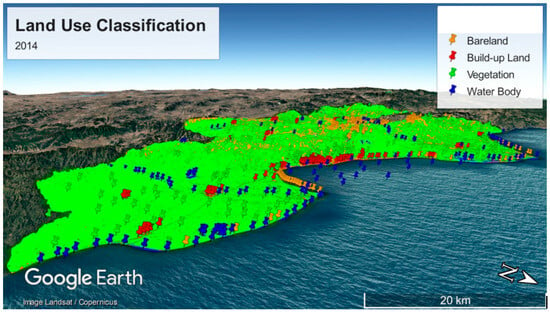
Figure 1.
Study area and land use classification.
2.2. Data
The primary data for this study comprised cloud-free Landsat 8 imagery, obtained from the US Geological Survey (USGS) via the Google Earth Engine (GEE) platform. The imagery covered two distinct periods: January to December 2014 and January to December 2023. These periods were selected to analyze the changes in land use and land cover over nearly a decade, providing insights into temporal dynamics and trends. Additionally, the study focused on the administrative boundaries of Samsun, Turkiye. The exact geographical boundaries for Samsun were extracted from the FAO Global Administrative Unit Layers (GAUL) dataset (2015 edition) available within the GEE. This feature collection specifically identifies administrative regions, ensuring precise area delineation for satellite image analysis.
The Landsat 8 OLI/TIRS Level-2 Surface Reflectance and Surface Temperature products were used. Multispectral bands (Bands 1–7) have a spatial resolution of 30 m, while the thermal bands (Bands 10–11) have an original resolution of 100 m, resampled to 30 m in GEE. The imagery was selected from cloud-free scenes over the entire calendar years of 2014 and 2023. Radiometric and geometric corrections were performed by USGS, ensuring data consistency for temporal comparison.
2.3. Methodology
Satellite images underwent several preprocessing steps to enhance their suitability for accurate classification and further steps are shown in Figure 2.
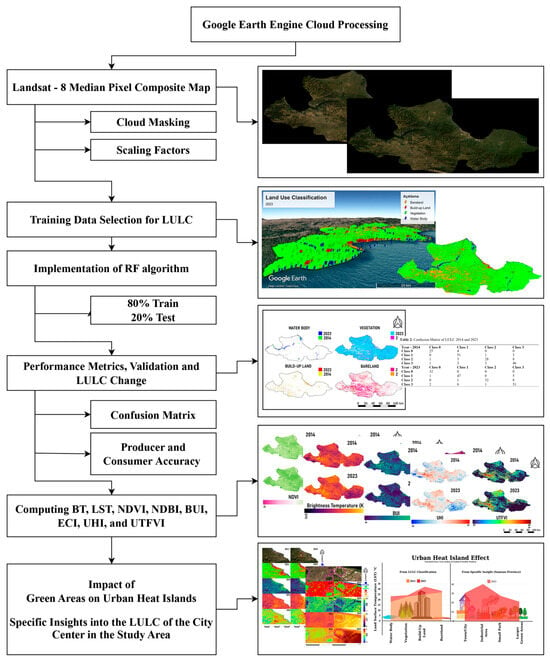
Figure 2.
The methodology followed in this study.
Cloud Masking: A cloud masking function was applied to each image using quality assessment (QA) bands. This function identifies and masks clouds and their shadows, ensuring that only clear-sky observations are included in the analysis. Specifically, a cloud bit (bit 5) and the cloud shadow bit (bit 3) are used. An image pixel is masked out if either the cloud bit or the cloud shadow bit is set to 1, indicating the presence of clouds or their shadows, respectively [40]. This ensures that only pixels representing clear-sky conditions are retained for further analysis.
Scaling Factors: The scaling of Landsat 8 imagery was performed to convert digital numbers (DNs) into physically meaningful reflectance and temperature values, making the data suitable for quantitative analysis. Reflectance and temperature bands were scaled to their true values using specific coefficients provided in the Landsat 8 data user guide [41,42].
2.3.1. Data Preprocessing
In this study, a one-year median composite of Landsat 8 imagery was utilized for each evaluation year to ensure the robustness and consistency of the land cover classification across Samsun’s diverse ecological and climatic conditions. Calculating the median composite [43] helps to minimize the influence of seasonal variations and temporary anomalies such as snow or agricultural cycles, which can drastically alter spectral signatures [44]. This method also mitigates issues such as cloud cover, snow cover and atmospheric variations [45] ensuring higher quality and more consistent imagery. By providing a stable baseline, the median composite facilitates accurate comparative analysis of land cover changes over time, enhancing ability of the study to accurately track and analyze environmental transformations.
2.3.2. Random Forest (RF) Algorithm
A machine learning algorithm, specifically the random forest classifier [46] was employed due to its efficacy in handling high-dimensional data and its robustness against overfitting [47]. The classifier was trained with 100 trees, utilizing both spectral and textural features derived from the Landsat imagery. The classifier was trained using a dataset specifically compiled for Samsun, Turkiye. To develop and validate the land cover classification model, a training and validation datasets were meticulously compiled. This dataset consists of approximately 1000 sample points that are evenly distributed across five primary land cover categories: water, vegetation, urban, bareland, and crop. Each category was represented by approximately 250 sample points to ensure a balanced dataset that reflects the diversity and distribution of land cover types within the study area.
An 80–20 train/test split was applied, with no separate validation set beyond this division. However, spatial representativeness was ensured by evenly distributing training points across the study area and verifying them through visual interpretation of high-resolution imagery.
2.3.3. Index Calculations
The selection of BT, LST, NDVI, NDBI, BUI, ECI, SUHI, and UTFVI was motivated by their widespread use in assessing urban thermal dynamics from complementary perspectives. While BT and LST offer direct temperature measures, NDVI and NDBI capture ecological and anthropogenic surface traits. BUI integrates built-up pressure, ECI reflects ecological vulnerability under thermal stress, and SUHI and UTFVI characterize thermal disparity and heat island intensity. Their joint application enables a more holistic and multi-scalar understanding of the urban heat island phenomenon. Previous studies have shown that integrated index approaches provide higher robustness in both spatial pattern detection and temporal trend analysis (e.g., [48,49]).
2.3.4. Defining Urban and Rural Zones
To define urban and rural zones, we relied on the results of our land cover classification, which provided a high-resolution representation of land use types across the study area. Urban zones were delineated by identifying contiguous pixels classified as “Built-up,” capturing densely constructed environments. In contrast, rural zones were defined by selecting pixels labeled as “Vegetation” and “Bareland” that were located beyond a 2 km buffer from the outer boundary of urban areas. This buffer was applied to minimize transitional or mixed-use zones and to reduce potential edge effects that could distort comparisons between urban and rural areas. The 2 km threshold was chosen to ensure a clearer thermal contrast between distinctly urban and rural surfaces, thereby enhancing the robustness of subsequent analyses.
Land surface temperature (LST) was estimated through a multi-step process involving (1) computation of brightness temperature (BT) from thermal bands, (2) derivation of NDVI from red and NIR bands, (3) calculation of fractional vegetation cover (FV), (4) estimation of land surface emissivity (EM), and (5) final LST derivation using the corrected Planck function. All calculations were conducted within the Google Earth Engine platform using pre-validated equations [50,51].
BT: Brightness temperature is the temperature that a black body would have if it emitted the same amount of radiation per unit area at a specific wavelength. This concept is used to derive the actual temperature of Earth’s surface features (such as land or water) based on the thermal radiation they emit [52] (Equation (1)).
NDVI: The normalized difference vegetation index is a widely used remote sensing index that measures the health and vigour of vegetation. It calculates the difference between the near-infrared (NIR) and visible red light reflected by vegetation, normalized by the sum of these bands [53]. The formula for the NDVI is (Equation (2)):
NDBI: The NDBI, or normalized difference built-up index, is a remote sensing index specifically designed to identify and quantify urban and built-up areas. It utilizes the spectral characteristics of built-up materials, which tend to reflect more shortwave infrared (SWIR) light than near-infrared (NIR) light [48]. The formula for calculating NDBI is (Equation (3)):
FV: The fraction of vegetation represents the percentage of an area that is covered by vegetation, providing a quantitative measure crucial for ecological and environmental assessments. It is typically determined using remote sensing techniques, such as the NDVI, to evaluate land use, monitor ecosystem health, and analyze the impacts of vegetation on climate (Dwipayana & Suryana, 2023) [54]. Additionally, calculating Fractional Vegetation (FV) and Emissivity (EM) is crucial for determining LST [55] (Equation (4))
Emissivity (EM) (Equation (5)):
Land Surface Temperature (LST) (Equation (6)):
Urban Heat Island (SUHI): An urban heat island (SUHI) arises when the temperatures in city centers are higher than those in surrounding areas. To analyze changes in the SUHI effect over different years, LST was computed as described and subsequently utilized in the SUHI formula for comparative assessment [56] (Equation (7)).
Urban Thermal Field Variance Index (UTFVI): This index measures the thermal differences between urban and nonurban areas by analyzing land surface temperatures. The UTFVI is especially useful for pinpointing areas within cities that have higher temperatures due to factors such as reduced vegetation cover, increased built-up surfaces, and human activities [57] (Equation (8)).
Built-up Index (BU): The built-up index (BU) is a remote sensing metric used to identify and quantify urbanized areas. It differentiates built-up surfaces, such as buildings and roads, from natural land cover, such as vegetation and water bodies [58] (Equation (9)).
Stretching to 255 (for LST and NDVI) (Equation (10)):
Environmental Criticality Index (ECI): Increasing LST and decreasing NDVI have put the environment in a critical state, as indicated by the environmental criticality index (ECI). Higher surface temperatures have been directly linked to increased ECIs [59] (Equation (11)).
3. Results
3.1. LULC Classification and Model Performance
The results indicate significant changes in land use and land cover in the region from 2014 to 2023 (Figure 3). The water body class has experienced a substantial increase, with the pixel count increasing from 323,762 in 2014 to 382,776 in 2023. This corresponds to an increase in area from 23.51 km2 to 27.80 km2, reflecting an 18.24% expansion. In contrast, the vegetation class slightly decreased, with the pixel count decreasing from 11,192,914 in 2014 to 11,054,982 in 2023. This decrease in area from 812.91 km2 to 802.89 km2 represents a minor decrease of 1.23%. The urban class has experienced significant growth, with the pixel count increasing from 228,694 in 2014 to 258,473 in 2023. This increase in area from 16.61 km2 to 18.77 km2 reflects a 13.00% increase, indicating notable urban expansion over the study period. Finally, the number of pixels in the bareland slightly increased from 2,808,374 in 2014 to 2,857,513 in 2023. This increase in area from 203.95 km2 to 207.53 km2 signifies a 1.75% increase (Table 1).
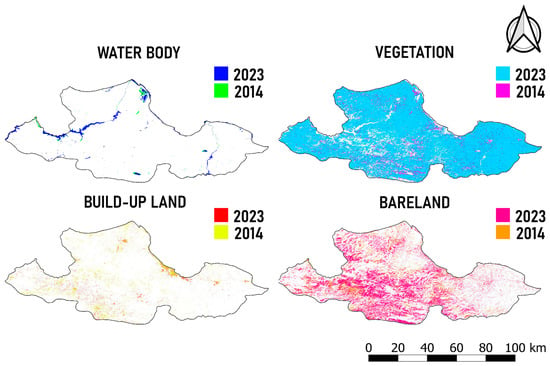
Figure 3.
LULC classes 2014 and 2023.

Table 1.
LULC Classification 2014 and 2023.
The confusion matrices for 2014 and 2023 reveal the accuracy and misclassification trends in land use and land cover classification. The overall classification accuracy was 89.4% for 2014 and 88.1% for 2023, with kappa coefficients of 0.86 and 0.85, respectively. In 2014, for water bodies (Class 0), 25 pixels were correctly classified, with 4 misclassified as vegetation (Class 1). Vegetation had 51 correctly classified pixels, with minor misclassifications into urban areas (Class 2) and barelands (Class 3). The urban areas included 28 correctly classified pixels but were misclassified into other classes, notably 8 pixels into barelands. There were 46 correctly classified pixels for the barelands, with some misclassified as water bodies, vegetation, and urban areas. By 2023, water bodies improved, with 32 correctly classified pixels and no misclassifications, making them the best-classified class. Vegetation revealed 47 correctly classified pixels but faced misclassifications, including 5 pixels into barelands. The urban areas improved with 32 correctly classified pixels and fewer misclassifications. The barelands had 31 correctly classified pixels but experienced increased misclassifications from vegetation and water bodies, making them the worst-classified class (Table 2).

Table 2.
Confusion matrix of LULC in 2014 and 2023.
The RF-LULC algorithm’s performance from 2014 to 2023 indicates notable changes in classification accuracy across the four classes. In 2014, vegetation had the highest producer accuracy at 0.93, while water bodies had the highest consumer accuracy at 0.93, with urban areas showing the lowest producer accuracy at 0.70. By 2023, the classification of water bodies improved significantly, achieving a perfect producer’s accuracy of 1.00, although its consumer’s accuracy slightly decreased to 0.91. Urban areas showed a notable increase in consumer’s accuracy to 0.97, reflecting high classification reliability. Vegetation maintained high accuracy with slight variations, while barelands exhibited the lowest accuracies in both producer (0.78) and consumer (0.70) catchments in 2023, indicating ongoing challenges in accurately classifying this class. Overall, the algorithm demonstrated improved performance in classifying water bodies and urban Areas over time, with consistent difficulties in accurately classifying barelands. The overall accuracy of the RF-LULC algorithm slightly improved from 2014 to 2023. In 2014, the overall accuracy was 0.85, indicating that 85% of the classifications across all land use and land cover classes were correct. By 2023, the overall accuracy increased marginally to 0.86 (Table 3).

Table 3.
Performance of the RF-LULC Algorithm.
3.2. BT and LST
The BT and LST values for various land cover types between 2014 and 2023 show significant changes. For water bodies, the mean BT increased from 288.70 K in 2014 to 293.94 K in 2023, and the mean LST increased from 18.28 °C to 23.49 °C, indicating a rise in surface temperature. The vegetation areas exhibited an increase in the mean BT from 293.51 K to 294.90 K and an increase in the mean LST from 22.72 °C to 24.09 °C, reflecting higher surface temperatures. Urban areas experienced a substantial rise in mean and land surface temperature, climbing from 25.40 °C in 2014 to 31.42 °C in 2023 —an increase that underscores the intensifying heat retention in densely built-up zones. In contrast, vegetated surfaces exhibited a more modest temperature rise of approximately 1.4 °C, reflecting the relative thermal stability provided by natural land cover (Figure 4). Bareland areas showed an increase in the mean BT from 297.53 K to 298.34 K and an increase in the mean LST from 26.94 °C to 27.71 °C, indicating a rise in surface temperature. Across all land cover types, the standard deviations and ranges of both BT and LST increased, indicating greater variability and a broader range of temperatures over the study period. These changes suggest a general increase in land surface temperatures and variability from 2014 to 2023, with urban areas experiencing the most significant temperature increase (Table 4).
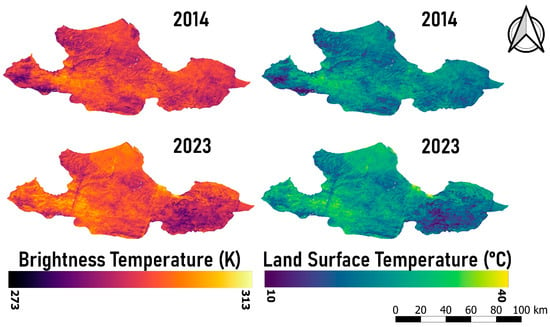
Figure 4.
Spatial map of BT and LST.

Table 4.
Descriptive Statistics of BT and LST.
3.3. NDVI and NDBI
The NDVI and NDBI values for various land cover types show significant changes between 2014 and 2023 (Figure 5). For water bodies, the mean NDVI increased from −0.06 in 2014 to 0.00 in 2023, with the standard deviation remaining constant, indicating negligible change in vegetation presence. The mean NDBI for water bodies decreased from −0.11 to −0.20, suggesting a reduction in built-up area characteristics. Vegetation areas exhibited an increase in the mean NDVI from 0.61 to 0.69, reflecting improved vegetation health, while the mean NDBI decreased from −0.14 to −0.22, indicating reduced built-up influence. Urban areas showed a slight increase in the mean NDVI from 0.30 to 0.31, with an increase in the standard deviation, indicating greater variability in vegetation. The mean NDBI for urban areas decreased from 0.02 to 0.00, reflecting minimal changes in built-up area characteristics. Bareland areas displayed an increase in the mean NDVI from 0.41 to 0.50, suggesting increased vegetation presence, while the mean NDBI decreased from 0.00 to −0.07, indicating a reduction in built-up characteristics (Table 5).
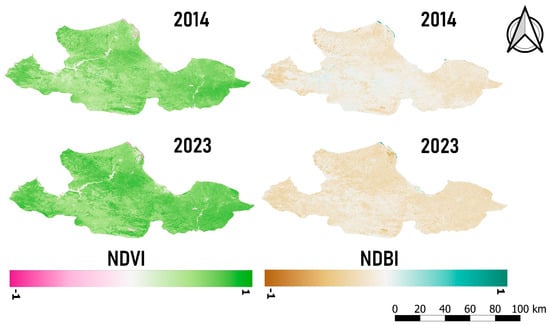
Figure 5.
Spatial map of NDVI and NDBI.

Table 5.
Descriptive Statistics of the NDVI and NDBI.
3.4. BUI and ECI
The descriptive statistics for the BUI and the ECI for the years 2014 and 2023 reveal notable trends across different land cover types (Figure 6). For the BUI, the mean water area slightly decreased from −0.05 in 2014 to −0.20 in 2023, indicating a reduction in the built-up intensity. Vegetation areas also experienced a decrease, with mean values decreasing from −0.76 to −0.91, suggesting less anthropogenic impact over time. Urban areas and bareland both exhibited slight decreases in their BUI means, reflecting marginal changes in urbanization and bareland conditions. For the ECI, the mean water area slightly increased from 8.43 to 8.85, while the mean vegetation area slightly decreased from 1.72 to 1.50. The mean ECIs of the urban areas increased from 3.94 to 4.52, indicating greater environmental stress, whereas those of the bareland areas decreased from 2.63 to 2.12 (Table 6).
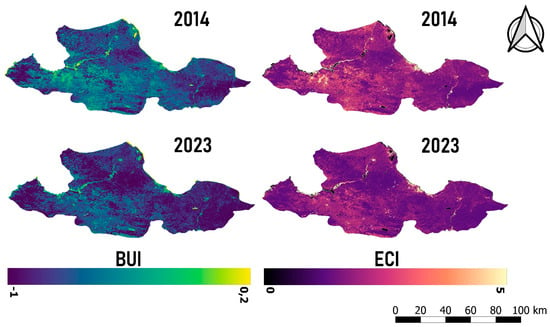
Figure 6.
Spatial map of BUI and ECI.

Table 6.
Descriptive Statistics of BUI and ECI.
3.5. SUHI and UTFVI
The SUHI and UTFVI values for various land cover types reveal considerable differences. For water bodies, the mean SUHI decreased slightly from −0.34 to −0.29, while the standard deviation remained nearly constant, indicating consistent variability. The mean UTFVI for water bodies also decreased slightly from −0.12 to −0.10, with a significant reduction in standard deviation, reflecting more consistent temperatures (Figure 7). The vegetation areas exhibited a stable mean SUHI effect of −0.17 across both periods, with a consistent standard deviation. The mean UTFVI remained unchanged at −0.08, but the standard deviation increased, indicating greater variability in temperature. Urban areas experienced an increase in the mean SUHI effect from 0.82 to 1.33, suggesting an increase in the urban heat island intensity, with a stable standard deviation. The mean UTFVI for urban areas increased from 0.12 to 0.19, with a slight reduction in standard deviation, indicating less variability. Bareland areas exhibited a slight decrease in the mean SUHI effect from 0.64 to 0.57, with a consistent standard deviation, and the mean UTFVI remained nearly unchanged, with a slight reduction in the standard deviation (Table 7).
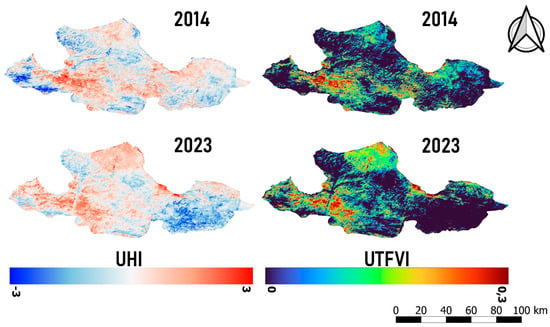
Figure 7.
Spatial map of SUHI and UTFVI.

Table 7.
Descriptive Statistics of the SUHI and UTFVI.
A comprehensive analysis of various indices and land use/land cover (LULC) data between 2014 and 2023 revealed significant trends and discrepancies. The BT and LST values for all land cover types indicate an overall increase in surface temperature, with urban areas showing the most notable increase, reflecting intensified urban heat island effects. The NDVI values suggest an increase in vegetation health across all land cover types, while the NDBI values reflect a decrease in built-up characteristics, especially in vegetation and bareland areas. The BUI (built-up index) also shows a decrease, indicating a reduction in urbanized surfaces, whereas the ECI (ecological condition index) values display varying trends: a slight increase for water and urban areas but a decrease for vegetation and bareland, suggesting shifts in ecological conditions. SUHI values indicate increased heat island intensity in urban areas and a reduction in cooling effects on water bodies. The UTFVI (urban thermal field variance index) values underscore increased thermal variability in urban areas, with significant fluctuations in vegetation areas. The discrepancies between indices such as BT, LST, and NDVI suggest a complex interplay between increased surface temperatures and vegetation health, while changes in the NDBI, BUI, and ECI indicate evolving land cover dynamics and ecological conditions. The data point to significant environmental changes, particularly in urban and bareland areas, which demand closer attention for sustainable land management and urban planning.
3.6. Impact of Green Areas on Urban Heat Islands
The presence of green spaces is critically important in mitigating the SUHI phenomenon. This study utilizes annual pixel medians derived from Landsat images for the year 2014 to compare urban and vegetative surfaces within a city center. Specifically, three distinct areas were selected for this comparison: a cemetery, a park, and a forest (magenta circles). These areas were chosen due to their varying degrees of vegetation and their relative proximity to urban structures. An analysis of LST values revealed that these vegetative areas exhibit significantly lower temperatures compared to their surrounding urban fabrics, which have a BUI ranging from 0.15 to 0.20. The LST in the cemetery area was 20.9 °C, that in the park was 26.1 °C, and that in the forested area was 21.8 °C. In stark contrast, the LST for adjacent structures such as highways and buildings averaged 30.2 °C. This stark difference underscores the cooling effect of vegetative areas in urban environments. Furthermore, the SUHI index, which quantifies the intensity of heat in urban areas compared to that in their rural surroundings, was calculated for these areas. The SUHI index was found to be −0.45 in the cemetery area, −0.37 in the forested area, and 0.09 in the park. In comparison, urban areas typically exhibit SUHI values ranging from 0.4 to 2.5, depending on the density and type of built structures. An additional analysis conducted on an industrial zone from 2023 provided further insights. A large green area within this zone, containing a few small buildings (1–2 stories), was sampled (BUI = −0.76). The average LST of this green area was recorded at 28.1 °C, while the surrounding industrial zone reached average temperatures of up to 40 °C. The SUHI index indicated particularly high temperature intensities in industrial areas, with the green area showing a SUHI value of 1.1, whereas the busiest streets and buildings in the industrial zone exhibited SUHI values ranging from 2.6 to 4.0. The temperature difference between green spaces and urban areas averaged 7–8 °C, with differences reaching 12 °C in industrial zones (Figure 8).
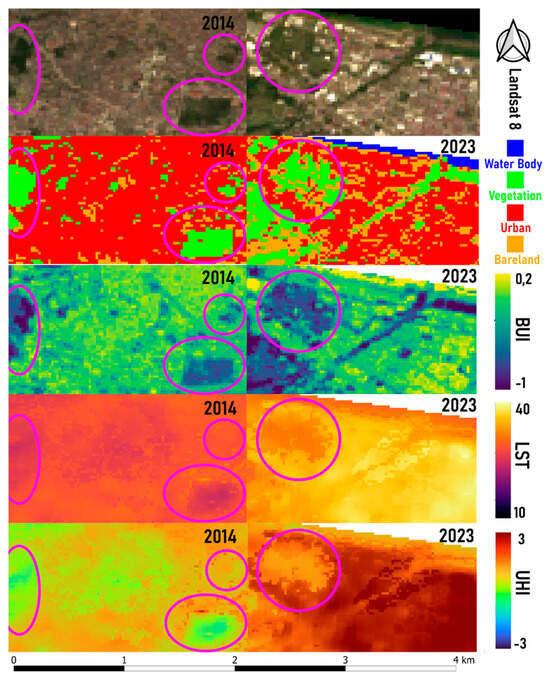
Figure 8.
Comparison of green and urban areas between 2014 (left) and 2023 (right) using Landsat 8 imagery and derived indices. The rose-colored circles highlight regions that were identified as green areas (vegetation) in 2014 and 2023. Top to bottom: True color composite, land cover classification, Built-Up Index (BUI), Land Surface Temperature (LST), and Urban Heat Island (UHI) intensity.
3.7. Specific Insights into the LULC of City Center in the Study Area
A comparative assessment between 2014 and 2023 revealed significant urban expansion, particularly towards the southwest. Satellite imagery clearly illustrates the establishment of an industrial site in the central part of the image, as well as the expansion of the organized industrial zone on the far right. These changes are further corroborated by the BUI analysis, which provides quantitative evidence of significant LULC transformations. In the southern regions of the city, the LST will increase from 24.9 °C in 2014 to 28.38 °C in 2023. Correspondingly, the SUHI index increased from 0.36 to 0.97 over the same period. In the preexisting urban areas, the LST increased from 27.5 °C to as high as 36.8 °C. The SUHI effect has not only intensified but also expanded its spatial coverage. In 2014, the SUHIs were approximately 0.74, whereas by 2023, values as high as 2.86 were observed. This trend indicates a substantial increase in the heat retention capacity of the urban fabric. Furthermore, the study revealed that the organized industrial zone significantly altered the surrounding meteorological conditions. An area predominantly covered with green spaces in 2014 was urbanized by 2023, as demonstrated by the LULC data. A particular area, marked with a red circle, had a BUI value of −0.68 in 2014, which increased to 0.18 by 2023. The LST in this area increased dramatically from 25.1 °C to 34.1 °C over the same period. The SUHI index, initially 0.3 in 2014, increased sharply to 1.81 by 2023 (Figure 9).
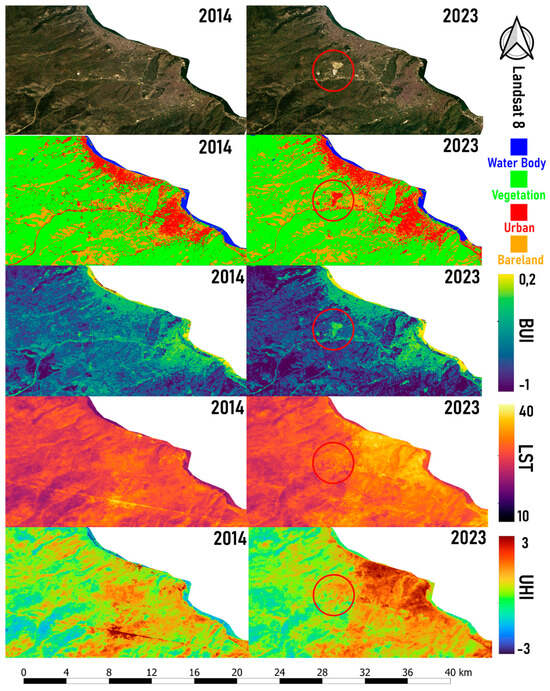
Figure 9.
Spatiotemporal comparison of land cover and surface characteristics between 2014 (left) and 2023 (right) using Landsat 8 imagery. The red circle indicates the newly established organized industrial zone, illustrating significant urban expansion over time. Top to bottom: true color composite, land cover classification, Built-Up Index (BUI), Land Surface Temperature (LST), and Urban Heat Island (UHI) intensity.
4. Discussion
4.1. Methodological Strengths and Classification Performance
Compared with alternative classification methods such as the support vector machine (SVM) or object-based image analysis (OBIA), the random forest (RF) classifier applied here exhibited robust performance, particularly in differentiating heterogeneous land use classes. Studies like [33,34] using SVM and OBIA, respectively, reported similar accuracy levels (83–88%), suggesting that RF remains competitive, especially when combined with median composites. Furthermore, using one-year median composites in GEE has been shown to reduce seasonal noise and yield more stable LULC estimates than single-date or max-NDVI-based compositing [43,60]. This methodological approach ensures consistency across years and enhances detection of long-term trends.
In this study, thermal and vegetative indices, including BT, LST, NDVI, NDBI, BUI, ECI, SUHI, and UTFVI, were examined to assess their dynamics across urban areas, green spaces, water bodies, and barren lands. This analysis utilized cloud-free Landsat 8 imagery sourced from the US Geological Survey via the Google Earth Engine platform, with a one-year median for each pixel. Studies have shown that using a one-year composite improves classification accuracy [43,60]. To achieve this goal, LULC classification was conducted using the random forest algorithm with satellite composite imagery. Overall accuracies of 85% for 2014 and 86% for 2023 were achieved. These success rates are similar to those reported in the literature [31,35]
However, the model faced difficulties distinguishing between bareland and urban areas due to their similar RGB tones, as indicated by the confusion matrix. Additionally, water body coverage appeared to have increased by 18.24%, which is attributed to the misclassification of the lake named “Balık Gölü” in the northwestern part of the study area in 2014. Shallow lakes or inland lakes with greenish hues are often confused with vegetation classes. As observed in other studies [61,62], an increase of 13% in urban areas has been noted, driven by the effects of urbanization. Nevertheless, the success rates achieved in this study are consistent with those reported in the literature. Thomlinson, Bolstad, and [63] established an overall accuracy target of 85%, with no individual class falling below 70% accuracy. Similarly, the USGS recommended an accuracy level of 85% as the minimum standard for land use/cover mapping using Landsat data [64].
4.2. Vegetation and Built-Up Index Dynamics
The most significant increase in the NDVI occurred in the vegetation (+0.08) and bareland (+0.09) areas, indicating that barren lands are becoming vegetated and that the existing vegetation is healthier [65]. Despite a 0.02 decrease in the NDBI in urban areas, the spatial NDBI in urban regions, especially in the northeastern part of the study area (the city center), increased due to urban expansion from 2014 to 2023. This trend is consistent with the findings of [66], who observed similar patterns of urban expansion and its effects on the NDBI and related vegetation indices. Additionally, the primary reason for the increase in the four classes of the NDVI is believed to be the increase in rainfall. In 2014, the total rainfall was 562.4 mm, while in 2023, nearly double that amount was recorded at 1084.0 mm [67]. A strong positive correlation is known to exist between NDVI and rainfall, indicating that NDVI consistently increases with rising rainfall levels [68]. Therefore, the differences between the NDVI and related indices are greater and will improve by 2023.
4.3. Environmental and Ecological Indices (BUI, ECI)
The BUI, which is derived from the NDVI, demonstrated a consistent pattern in this study, with BUI values decreasing across the entire study area, including urban regions (water = −0.15, vegetation = −0.15, urban = −0.03, bareland = −0.15). This decrease in BUI values reflects a general trend of increasing vegetative cover, even within urban settings. However, the spatial distribution of the BUI has increased, driven by the expansion of city and district centers, as well as organized industrial zones, highlighting the role of urban sprawl in altering land cover. Conversely, the ECI, which incorporates both the NDVI and LST, significantly increased in urban areas, increasing from 3.94 to 5.52. This increase indicates deteriorating environmental conditions, marked by increased temperatures and reduced vegetation. In contrast, the ECIs decreased in the vegetation and bareland classes, suggesting relatively stable or improving conditions in these areas. The phenomenon of high ECIs corresponding to areas of extreme environmental criticality is well-documented in the literature [69,70] reinforcing the link between urbanization and environmental stress.
4.4. SUHI and UTFVI Dynamics
The SUHI values for urban areas have shown a marked increase, increasing from 0.47 to 1.33, and this increase is accompanied by a spatial expansion as the city has grown, as shown for Samsun [38]. In contrast, the SUHI and UTFVI for green areas have remained relatively stable. However, there was a significant increase in both SUHIs and UTFVIs within the Kızılırmak Delta, which is a national park and protected area. This increase is particularly noteworthy and suggests environmental stress in these protected regions. For barren lands, the SUHI and UTFVI values are notably high. This is primarily attributed to the low levels of vegetation (FV) and the elevated land surface temperatures (LST), especially in the southern regions. Furthermore, Ref. [49] highlighted that linear regression analysis indicates a significant negative correlation between the fractional vegetation cover (FVC) and the urban thermal field variance index (UTFVI).
4.5. LST Patterns Across Land Cover Types
In the LULC classification, water bodies maintained low LST values below 23 °C for both years, while vegetation showed a slight increase, remaining at approximately 24 °C. Built-up land exhibited the greatest increase, from approximately 25 °C in 2014 to more than 31 °C in 2023. The bareland area also increased from approximately 27 °C to 28 °C. Specific insights from Samsun Province in 2023 indicate that town/city areas have LST values of approximately 30 °C, industrial areas are close to 40 °C, small parks are approximately 27 °C, and larger green areas are near 21 °C. Analysis using one-year median composite images revealed that the LST varied with the size and type of vegetation, with a mean LST differential between all green spaces and urban areas averaging 7–8 °C, and differences reaching 12 °C in industrial zones (Figure 10). This result is consistent with the literature: Ref. [71] reported that, on average, the mean LST of impervious surfaces (ISs) is approximately 3 °C higher than that of green spaces (GSs) in the megacities of Southeast Asia, and another study by [72] revealed a 6°C difference in Tehran.
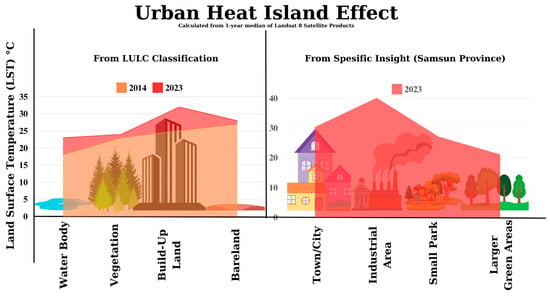
Figure 10.
Infographic of SUHI effect on LST.
4.6. Limitations and Future Directions
One limitation of the current study is the lack of direct quantification of anthropogenic heat emissions arising from transportation, industrial activities, and energy use. While elevated LST and SUHI values in industrial and densely urbanized areas—reaching up to 47.38 °C and SUHI values above 4.0—indirectly reflect these effects, more explicit modeling (e.g., surface energy balance, anthropogenic heat flux models, or urban climate modeling) would allow for a clearer attribution. Future work may incorporate urban activity data (e.g., traffic intensity, industrial output, energy consumption) or utilize models such as the Urban Canopy Model (UCM) or WRF-UCM coupling to quantify such contributions more accurately. It is acknowledged that the SUHI phenomenon is often more pronounced during nighttime due to the slower cooling of urban surfaces. However, as Landsat 8 only acquires images during mid-morning hours, this study reflects daytime SUHI patterns. Future studies may consider incorporating nighttime thermal data from MODIS or ECOSTRESS to capture full diurnal SUHI dynamics.
5. Conclusions
This study highlights the significant role of urban expansion and increased impervious surfaces in intensifying surface urban heat island (SUHI) effects, resulting in elevated land surface temperatures (LSTs) and heightened environmental stress, particularly in densely developed areas. Conversely, green spaces emerged as vital thermal regulators, effectively mitigating surface temperatures and enhancing environmental quality—evident from the stable or improved values of vegetative indices such as the NDVI and BUI.
The SUHI intensity increase observed in this study (from 0.47 to 1.33) aligns with similar trends documented in other cities (e.g., Kayseri, Istanbul, Tehran), reinforcing the representativeness and external validity of our findings. Moreover, the spatial analysis revealed up to 12 °C differences in LST between industrial zones and large green spaces, emphasizing the importance of urban vegetation in regulating local microclimates.
Methodologically, the study demonstrates the utility of integrating Google Earth Engine (GEE) with the random forest (RF) algorithm and multi-index composites to monitor urban thermal dynamics over time. Although classification accuracy was generally high, confusion was observed between bareland and urban areas, and between vegetated zones and shallow lakes with similar spectral signatures. Future studies could address this by expanding the number and distribution of training points, and by incorporating additional spectral or texture features to improve class separability.
Looking ahead, future research may incorporate nighttime thermal data (e.g., from MODIS or ECOSTRESS) to better capture diurnal variations in SUHI patterns. Additionally, integrating anthropogenic heat flux data and urban activity metrics (e.g., traffic density, energy consumption) could further enhance the explanatory power of SUHI analyses. Finally, applying this framework to different city sizes and climate zones would provide broader insights into the scalability and adaptability of remote sensing-based UHI-monitoring approaches.
Author Contributions
Y.K.: Conceptualization, formal analysis, methodology, software, data curation, investigation, validation, visualization, writing—original draft. V.Y.: Writing—review & editing, formal analysis, visualization. A.R.L.: Writing—review & editing. All authors have read and agreed to the published version of the manuscript.
Funding
This research did not receive any specific grant from funding agencies in the public, commercial, or not-for-profit sectors.
Institutional Review Board Statement
All authors have read, understood, and have complied as applicable with the statement on “Ethical responsibilities of Authors” as found in the Instructions for Authors.
Data Availability Statement
Data will be made available on request.
Conflicts of Interest
The authors declare no conflict of interest.
References
- Deilami, K.; Kamruzzaman, M.; Liu, Y. Urban heat island effect: A systematic review of spatio-temporal factors, data, methods, and mitigation measures. Int. J. Appl. Earth Obs. Geoinf. 2018, 67, 30–42. [Google Scholar] [CrossRef]
- Oke, T.R. The energetic basis of the urban heat island. Q. J. R. Meteorol. Soc. 1982, 108, 455. [Google Scholar] [CrossRef]
- Arnfield, A.J. Two decades of urban climate research: A review of turbulence, exchanges of energy and water, and the urban heat island. Int. J. Climatol. 2003, 23, 1–26. [Google Scholar] [CrossRef]
- Rızwan, A.M.; Dennıs, L.Y.C.; Lıu, C. A review on the generation, determination and mitigation of Urban Heat Island. J. Environ. Sci. 2008, 20, 120–128. [Google Scholar] [CrossRef]
- Santamouris, M. Analyzing the heat island magnitude and characteristics in one hundred Asian and Australian cities and regions. Sci. Total Environ. 2015, 512–513, 582–598. [Google Scholar] [CrossRef] [PubMed]
- Grimmond, S. Urbanization and global environmental change: Local effects of urban warming. Geogr. J. 2007, 173, 83–88. [Google Scholar] [CrossRef]
- Chen, X.-L.; Zhao, H.-M.; Li, P.-X.; Yin, Z.-Y. Remote sensing image-based analysis of the relationship between urban heat island and land use/cover changes. Remote Sens. Environ. 2006, 104, 133–146. [Google Scholar] [CrossRef]
- Tayanç, M.; Toros, H. Urbanızatıon Effects on Regıonal Clımate Change ın the Case of Four Large Cıtıes of Turkey. Clim. Change 1997, 35, 501–524. [Google Scholar] [CrossRef]
- Cai, M.; Ren, C.; Xu, Y.; Lau, K.K.-L.; Wang, R. Investigating the relationship between local climate zone and land surface temperature using an improved WUDAPT methodology—A case study of Yangtze River Delta, China. Urban Clim. 2018, 24, 485–502. [Google Scholar] [CrossRef]
- Gago, E.J.; Roldan, J.; Pacheco-Torres, R.; Ordóñez, J. The city and urban heat islands: A review of strategies to mitigate adverse effects. Renew. Sustain. Energy Rev. 2013, 25, 749–758. [Google Scholar] [CrossRef]
- Yılmaz, M.; Kara, Y.; Toros, H.; İncecik, S. Analysis of the summer thermal comfort indices in İstanbul. Int. J. Biometeorol. 2024, 68, 1327–1342. [Google Scholar] [CrossRef] [PubMed]
- Yang, J.; Wang, Z.-H.; Kaloush, K.E.; Brazel, A.J. Assessing the impact of urban geometry on surface urban heat island using complete and nadir temperatures. Int. J. Climatol. 2019, 40, 2019–2036. [Google Scholar] [CrossRef]
- Karaca, M.; Tayanç, M.; Toros, H. Effects of urbanization on climate of İstanbul and Ankara. Atmos. Environ. 1995, 29, 3411–3421. [Google Scholar] [CrossRef]
- Li, X.; Zhou, Y.; Yu, S.; Jia, G.; Li, H.; Li, W. Urban heat island impacts on building energy consumption: A review of approaches and findings. Energy 2019, 174, 407–419. [Google Scholar] [CrossRef]
- Hajat, S.; O’Connor, M.; Kosatsky, T. Health effects of hot weather: From awareness of risk factors to effective health protection. Lancet 2010, 375, 856–863. [Google Scholar] [CrossRef]
- Yılmaz, M.; Kara, Y.; Çulpan, H.C.; Can, G.; Toros, H. Detection and regional analysis of heatwave characteristics in İstanbul. Sustain. Cities Soc. 2023, 97, 104789. [Google Scholar] [CrossRef]
- Gislason, P.O.; Benediktsson, J.A.; Sveinsson, J.R. Random Forests for land cover classification. Pattern Recognit. Lett. 2006, 27, 294–300. [Google Scholar] [CrossRef]
- Amini, S.; Saber, M.; Rabiei-Dastjerdi, H.; Homayouni, S. Urban land use and land cover change analysis using Random Forest classification of Landsat time series. Remote Sens. 2022, 14, 2654. [Google Scholar] [CrossRef]
- Piao, Y.; Jeong, S.; Park, S.; Lee, D. Analysis of land use and land cover change using time-series data and Random Forest in North Korea. Remote Sens. 2021, 13, 3501. [Google Scholar] [CrossRef]
- Nguyen, H.T.T.; Doan, T.M.; Radeloff, V. Applying Random Forest classification to map land use/land cover using Landsat 8 OLI. Int. Arch. Photogramm. Remote Sens. Spat. Inf. Sci. 2018, 42, 363–367. [Google Scholar] [CrossRef]
- Mohammad, P.; Goswami, A. Quantifying diurnal and seasonal variation of surface urban heat island intensity and its associated determinants across different climatic zones over Indian cities. GIScience Remote Sens. 2021, 58, 955–981. [Google Scholar] [CrossRef]
- Wang, R.; Voogt, J.; Ren, C.; Ng, E. Spatial-temporal variations of surface urban heat island: An application of local climate zone into large Chinese cities. Build. Environ. 2022, 222, 109378. [Google Scholar] [CrossRef]
- Kara, Y.; Yavuz, V. Urban Microclimates in a Warming World: Land Surface Temperature (LST) Trends Across Ten Major Cities on Seven Continents. Urban Sci. 2025, 9, 115. [Google Scholar] [CrossRef]
- Clinton, N.; Gong, P. MODIS detected surface urban heat islands and sinks: Global locations and controls. Remote Sens. Environ. 2013, 134, 294–304. [Google Scholar] [CrossRef]
- Voogt, J.A.; Oke, T.R. Thermal remote sensing of urban climates. Remote Sens. Environ. 2003, 86, 370–384. [Google Scholar] [CrossRef]
- Weng, Q. Thermal infrared remote sensing for urban climate and environmental studies: Methods, applications, and trends. ISPRS J. Photogramm. Remote Sens. 2009, 64, 335–344. [Google Scholar] [CrossRef]
- Li, D.; Bou-Zeid, E.; Oppenheimer, M. The effectiveness of cool and green roofs as urban heat island mitigation strategies. Environ. Res. Lett. 2014, 9, 55002. [Google Scholar] [CrossRef]
- Weng, Q.; Lu, D.; Schubring, J. Estimation of land surface temperature–vegetation abundance relationship for urban heat island studies. Remote Sens. Environ. 2004, 89, 467–483. [Google Scholar] [CrossRef]
- Myint, S.W.; Wentz, E.A.; Brazel, A.J.; Quattrochi, D.A. The impact of distinct anthropogenic and vegetation features on urban warming. Landsc. Ecol. 2013, 28, 959–978. [Google Scholar] [CrossRef]
- Jothimani, M.; Gunalan, J.; Duraisamy, R.; Abebe, A. Study the Relationship Between LULC, LST, NDVI, NDWI and NDBI in Greater Arba Minch Area, Rift Valley, Ethiopia. In Proceedings of the 3rd International Conference on Integrated Intelligent Computing Communication Security (ICIIC 2021), Bangaluru, India, 6–7 August 2021; Atlantis Press: Dordrecht, The Netherlands, 2021; pp. 183–193. [Google Scholar] [CrossRef]
- Pande, C.B.; Moharir, K.N.; Varade, A.M.; Abdo, H.G.; Mulla, S.; Yaseen, Z.M. Intertwined impacts of urbanization and land cover change on urban climate and agriculture in Aurangabad city (MS), India using google earth engine platform. J. Clean. Prod. 2023, 422, 138541. [Google Scholar] [CrossRef]
- Saputra, L.I.A.; Sari, D.N. Analysis of Environmental Criticality Index (ECI) and Distribution of Slums in Yogyakarta and Surrounding Areas Using Multitemporal Landsat Imagery. In Proceedings of the International Conference of Geography and Disaster Management (ICGDM 2022), Online, 5–7 December 2022; Atlantis Press: Dordrecht, The Netherlands, 2023; pp. 407–420. [Google Scholar] [CrossRef]
- Liu, Z.; Chen, Y.; Chen, C. Analysis of the Spatiotemporal Characteristics and Influencing Factors of the NDVI Based on the GEE Cloud Platform and Landsat Images. Remote Sens. 2023, 15, 4980. [Google Scholar] [CrossRef]
- Amindin, A.; Pouyan, S.; Pourghasemi, H.R.; Yousefi, S.; Tiefenbacher, J.P. Spatial and temporal analysis of urban heat island using Landsat satellite images. Environ. Sci. Pollut. Res. 2021, 28, 41439–41450. [Google Scholar] [CrossRef] [PubMed]
- Karakuş, C.B. The Impact of Land Use/Land Cover (LULC) Changes on Land Surface Temperature in Sivas City Center and Its Surroundings and Assessment of Urban Heat Island. Asia-Pac. J. Atmos. Sci. 2019, 55, 669–684. [Google Scholar] [CrossRef]
- Dihkan, M.; Karsli, F.; Guneroglu, A.; Guneroglu, N. Evaluation of surface urban heat island (SSUHI) effect on coastal zone: The case of Istanbul Megacity. Ocean Coast. Manag. 2015, 118, 309–316. [Google Scholar] [CrossRef]
- Cetin, M.; Ozenen Kavlak, M.; Senyel Kurkcuoglu, M.A.; Bilge Ozturk, G.; Cabuk, S.N.; Cabuk, A. Determination of land surface temperature and urban heat island effects with remote sensing capabilities: The case of Kayseri, Türkiye. Nat. Hazards 2024, 120, 5509–5536. [Google Scholar] [CrossRef]
- Cevik Degerli, B.; Cetin, M. Evaluation of UTFVI index effect on climate change in terms of urbanization. Environ. Sci. Pollut. Res. 2023, 30, 75273–75280. [Google Scholar] [CrossRef]
- Samsun Metropolitan Municipality (SMM). “Coğrafi Yapı ve İklim” in Turkish. 2024. Available online: https://samsun.bel.tr/icerik/cografi-yapi-ve-iklim (accessed on 20 July 2024).
- Chai, D.; Newsam, S.; Zhang, H.K.; Qiu, Y.; Huang, J. Cloud and cloud shadow detection in Landsat imagery based on deep convolutional neural networks. Remote Sens. Environ. 2019, 225, 307–316. [Google Scholar] [CrossRef]
- Vermote, E.; Justice, C.; Claverie, M.; Franch, B. Preliminary analysis of the performance of the Landsat 8/OLI land surface reflectance product. Remote Sens. Environ. 2016, 185, 46–56. [Google Scholar] [CrossRef]
- Cook, M.; Schott, J.R.; Mandel, J.; Raqueno, N. Development of an operational calibration methodology for the Landsat thermal data archive and initial testing of the atmospheric compensation component of a Land Surface Temperature (LST) Product from the archive. Remote Sens. 2014, 6, 1244. [Google Scholar] [CrossRef]
- Nasiri, V.; Deljouei, A.; Moradi, F.; Sadeghi, S.M.M.; Borz, S.A. Land Use and Land Cover Mapping Using Sentinel-2, Landsat-8 Satellite Images, and Google Earth Engine: A Comparison of Two Composition Methods. Remote Sens. 2022, 14, 1977. [Google Scholar] [CrossRef]
- Neetu Ray, S. Crop area estimation with Remote Sensing. In Handbook on Remote Sensing for Agricultural Statistics; Handbook of the Global Strategy to Improve Agricultural and Rural Statistics (GSARS); FAO: Rome, Italy, 2017; Chapter 5. [Google Scholar]
- Pflugmacher, D.; Rabe, A.; Peters, M.; Hostert, P. Mapping pan-European land cover using Landsat spectral-temporal metrics and the European LUCAS survey. Remote Sens. Environ. 2019, 221, 583–595. [Google Scholar] [CrossRef]
- Liu, Y.; Wang, Y.; Zhang, J. New Machine Learning Algorithm: Random Forest. In Information Computing and Applications; Liu, B., Ma, M., Chang, J., Eds.; Springer: Berlin/Heidelberg, Germany, 2012; pp. 246–252. [Google Scholar]
- Do, T.-N.; Lenca, P.; Lallich, S.; Pham, N.-K. Classifying Very-High-Dimensional Data with Random Forests of Oblique Decision Trees. In Advances in Knowledge Discovery and Management; Guillet, F., Ritschard, G., Zighed, D.A., Briand, H., Eds.; Springer: Berlin/Heidelberg, Germany, 2010; pp. 39–55. [Google Scholar] [CrossRef]
- Guha, S.; Govil, H.; Gill, N.; Dey, A. A long-term seasonal analysis on the relationship between LST and NDBI using Landsat data. Quat. Int. 2021, 575–576, 249–258. [Google Scholar] [CrossRef]
- Zhang, M.; Tan, S.; Zhang, C.; Han, S.; Zou, S.; Chen, E. Assessing the impact of fractional vegetation cover on urban thermal environment: A case study of Hangzhou, China. Sustain. Cities Soc. 2023, 96, 104663. [Google Scholar] [CrossRef]
- Chander, G.; Markham, B.L.; Helder, D.L. Summary of current radiometric calibration coefficients for Landsat MSS, TM, ETM+, and EO-1 ALI sensors. Remote Sens. Environ. 2009, 113, 893–903. [Google Scholar] [CrossRef]
- Sobrino, J.A.; Jiménez-Muñoz, J.C.; Paolini, L. Land surface temperature retrieval from LANDSAT TM 5. Remote Sensing of Environment 2004, 90, 434–440. [Google Scholar] [CrossRef]
- Djikpo, V.A.R.; Teka, O.; Azihou, F.; Toko, I.; Oumorou, M.; Sinsin, B. Comparative assessment of the accuracies of daytime land surface temperature retrieval methods using Landsat 8 and MODIS imageries in Benin, West Africa. J. Appl. Remote Sens. 2023, 17, 34504. [Google Scholar] [CrossRef]
- Robinson, N.P.; Allred, B.W.; Jones, M.O.; Moreno, A.; Kimball, J.S.; Naugle, D.E.; Erickson, T.A.; Richardson, A.D. A Dynamic Landsat Derived Normalized Difference Vegetation Index (NDVI) Product for the Conterminous United States. Remote Sens. 2017, 9, 863. [Google Scholar] [CrossRef]
- Dwipayana, M.; Suryana, I.G.P.E. Utilization of Remote Sensing and GIS Applications for Detecting Vegetation Density and Land Surface Temperature Using Landsat 8 Imagery (Banyuwangi Regency Case Study in 2019). In Proceedings of the 4th International Conference on Law, Social Sciences, and Education, ICLSSE 2022, Singaraja, Bali, Indonesia, 28 October 2022; EAI, EUDL: The Hague, The Netherlands, 2023. [Google Scholar] [CrossRef]
- Değermenci, A.S. Estimation of land surface temperature from Landsat-8 OLI: Comparative analysis of two periods for Duzce in Turkey. Int. J. Environ. Sci. Technol. 2024, 21, 6389–6404. [Google Scholar] [CrossRef]
- Çelik, M.; Yakar, M. Land Surface Temperature and Urban Heat Island Analysis Using Remote Sensing and GIS: A Case Study in Mersin. In Proceedings of the 7th Intercontinental Geoinformation Days, Peshawar, Pakistan, 18–19 November 2023; pp. 298–301. [Google Scholar]
- Naim, M.N.H.; Kafy, A.-A. Assessment of urban thermal field variance index and defining the relationship between land cover and surface temperature in Chattogram city: A remote sensing and statistical approach. Environ. Chall. 2021, 4, 100107. [Google Scholar] [CrossRef]
- Bhatti, S.S.; Tripathi, N.K. Built-up area extraction using Landsat 8 OLI imagery. GIScience Remote Sens. 2014, 51, 445–467. [Google Scholar] [CrossRef]
- Bhattacharyya, S.; Sinha, S.; Kumari, M.; Mishra, V.N.; Hasher, F.F.B.; Szostak, M.; Zhran, M. Spatio-Temporal Influences of Urban Land Cover Changes on Thermal-Based Environmental Criticality and Its Prediction Using CA-ANN Model over Kolkata (India). Remote Sens. 2025, 17, 1082. [Google Scholar] [CrossRef]
- Xie, S.; Liu, L.; Zhang, X.; Yang, J.; Chen, X.; Gao, Y. Automatic Land-Cover Mapping using Landsat Time-Series Data based on Google Earth Engine. Remote Sens. 2019, 11, 3023. [Google Scholar] [CrossRef]
- Choudhury, U.; Singh, S.K.; Kumar, A.; Meraj, G.; Kumar, P.; Kanga, S. Assessing Land Use/Land Cover Changes and Urban Heat Island Intensification: A Case Study of Kamrup Metropolitan District, Northeast India (2000–2032). Earth 2023, 4, 503–521. [Google Scholar] [CrossRef]
- Hamed Fahmy, A.; Amin Abdelfatah, M.; El-Fiky, G. Investigating land use land cover changes and their effects on land surface temperature and urban heat islands in Sharqiyah Governorate, Egypt. Egypt. J. Remote Sens. Space Sci. 2023, 26, 293–306. [Google Scholar] [CrossRef]
- Cohen, W.B.; Spies, T.A.; Fiorella, M. Estimating the age and structure of forests in a multi-ownership landscape of western Oregon, U.S.A. Remote Sens. Environ. 1999, 70, 167–180. [Google Scholar] [CrossRef]
- Anderson, J.R. A Land Use and Land Cover Classification System for Use with Remote Sensor Data; US Government Printing Office: Washington, DC, USA, 1976; Volume 964.
- Al-Kubaisy, A.R. Assessment of vegetal cover changes using Normalized Difference Vegetation Index (NDVI) and subtractive (NDVI) time-series, Karbala province, Iraq. Int. J. Phys. 2018, 15, 133–141. Available online: https://ijp.uobaghdad.edu.iq/index.php/physics/article/view/62 (accessed on 19 July 2024).
- Zheng, Y.; Tang, L.; Wang, H. An improved approach for monitoring urban built-up areas by combining NPP-VIIRS nighttime light, NDVI, NDWI, and NDBI. J. Clean. Prod. 2021, 328, 129488. [Google Scholar] [CrossRef]
- Turkish State Meteorological Service (TSMS). Meteorological Reports and Climate Data. 2024. Available online: https://www.mgm.gov.tr (accessed on 19 July 2024).
- Kundu, A.; Denis, D.M.; Patel, N.R.; Dutta, D. A Geo-spatial study for analysing temporal responses of NDVI to rainfall. Singap. J. Trop. Geogr. 2018, 39, 107–116. [Google Scholar] [CrossRef]
- Ćesić, M.; Rogulj, K.; Krtalić, A. Combined Thermal Index Development for Urban Heat Island Detection in Area of Split, Croatia. Land 2025, 14, 175. [Google Scholar] [CrossRef]
- Sasmito, B.; Suprayogi, A. Spatial Analysis of Environmental Critically due to Increased Temperature in The Built Up Area With Remote Sensing. IOP Conf. Ser. Earth Environ. Sci. 2018, 165, 12011. [Google Scholar] [CrossRef]
- Estoque, R.C.; Murayama, Y.; Myint, S.W. Effects of landscape composition and pattern on land surface temperature: An urban heat island study in the megacities of Southeast Asia. Sci. Total Environ. 2017, 577, 349–359. [Google Scholar] [CrossRef] [PubMed]
- Bokaie, M.; Zarkesh, M.K.; Arasteh, P.D.; Hosseini, A. Assessment of Urban Heat Island based on the relationship between land surface temperature and Land Use/Land Cover in Tehran. Sustain. Cities Soc. 2016, 23, 94–104. [Google Scholar] [CrossRef]
Disclaimer/Publisher’s Note: The statements, opinions and data contained in all publications are solely those of the individual author(s) and contributor(s) and not of MDPI and/or the editor(s). MDPI and/or the editor(s) disclaim responsibility for any injury to people or property resulting from any ideas, methods, instructions or products referred to in the content. |
© 2025 by the authors. Licensee MDPI, Basel, Switzerland. This article is an open access article distributed under the terms and conditions of the Creative Commons Attribution (CC BY) license (https://creativecommons.org/licenses/by/4.0/).